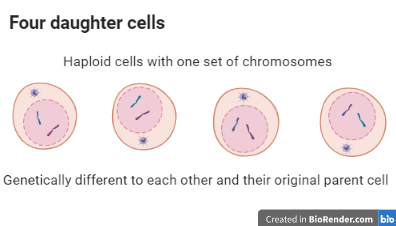In organisms that follow sexual reproduction, gametes combine to form the zygote, the first cell of a new organism. We will discuss the familiar case of humans, but the same applies to other organisms as well. The two gametes, sperm and egg, are haploid cells, meaning they contain half the chromosome number of somatic cells. This way, with fertilization, they will give rise to a diploid zygote. Therefore, as the diploid primordial germ cells are transformed into gametes, they must reduce their number of chromosomes in half. That is why they follow meiosis instead of mitosis. That is a process of two divisions that results in the formation of four haploid cells.
Preparation for meiosis
As a cell prepares for meiosis, it presents some of the procedures that we also saw in mitosis. It replicates its DNA to acquire duplicated homologous chromosomes. It makes a centrosome copy so that the meiotic spindle, similar to the mitotic spindle, will be formed at a later stage. It also condenses its DNA to facilitate division.
Meiosis includes two stages, each one comprising of the same phases and the same events, although there are some variations. So, we have meiosis I and meiosis II. The first is divided into prophase I, metaphase I, anaphase I, and telophase I, which is also accompanied by cytokinesis. Meiosis II is divided into prophase II, metaphase II, anaphase II, and telophase II, which is also accompanied by cytokinesis.
Meiosis I
At the end of meiosis I, two cells occur. Each of them contains one set of duplicated chromosomes.
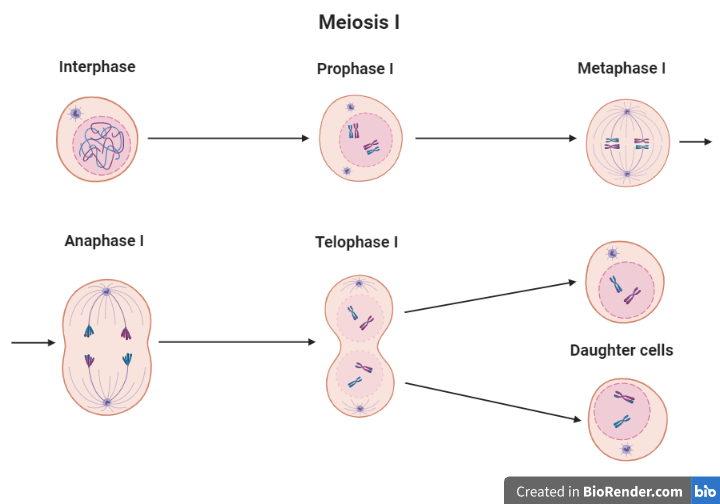
Prophase I
During prophase I, the duplicated chromosomes are condensed, acquiring an X-shaped structure. Each one consists of two identical sister chromatids. Contrary to mitosis, the two chromosomes of each homologous pair come together and exchange parts of their genetic information. For example, the maternal and paternal chromosomes of the first pair (the second, the third pair, etc.) undergo a process called crossing over or recombination. That increases the genetic diversity in the sex cells. An individual’s gamete will possess chromosomes with a combination of the paternal and maternal DNA of its parents. If the gamete takes part in fertilization, the zygote will contain a mix of its grandfather and grandmother’s genetic information in each of its chromosomes.
In addition to these events, the nuclear envelope is dissolved, and the chromosomes are released in the cytoplasm. A meiotic spindle is formed from the two centrosomes. The centrosomes move in opposite directions, with their microtubules binding to chromosomes.
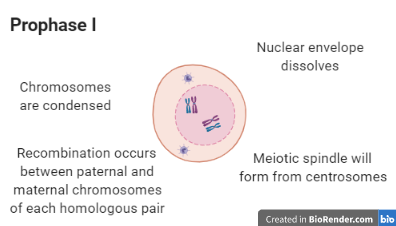
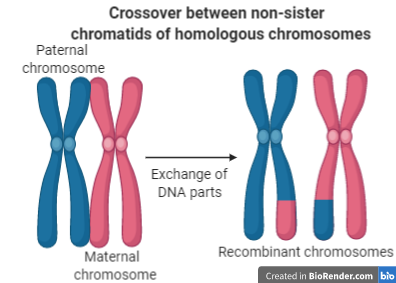
Metaphase I
Chromosomes are aligned at the cell’s equator, where they bind to spindle microtubules. The homologous chromosomes of each pair face one another. That means a microtubule emerging from one pole binds to one of the chromosomes, while a microtubule of the opposite pole binds to its homologous chromosome.
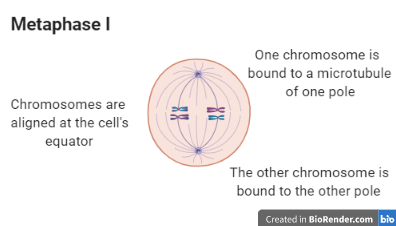
Anaphase I
In anaphase I, the microtubules pull the chromosomes towards the poles. Therefore, the two chromosomes of each pair end up in opposite poles, but they continue to consist of two sister chromatids, bound to their centromere.
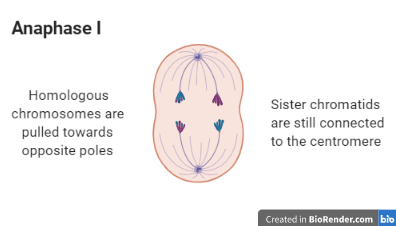
Telophase I and Cytokinesis
When the movement of chromosomes is completed, the formation of two new nuclear envelopes around each set of chromosomes begins. In addition to that, cytokinesis will split the cytoplasm in two. The result is the formation of two cells that are not genetically identical. Each of them contains a whole set of chromosomes, and therefore they are haploid cells. However, their chromosomes are still duplicated since the sister chromatids have not been separated yet.
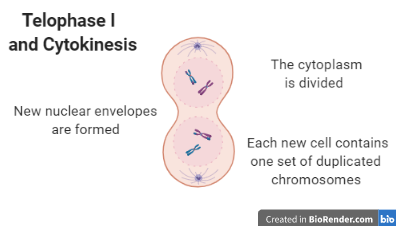
Meiosis II
At the end of meiosis II, four cells will emerge, each one with one set of chromosomes. These will then go on to become haploid gametes.
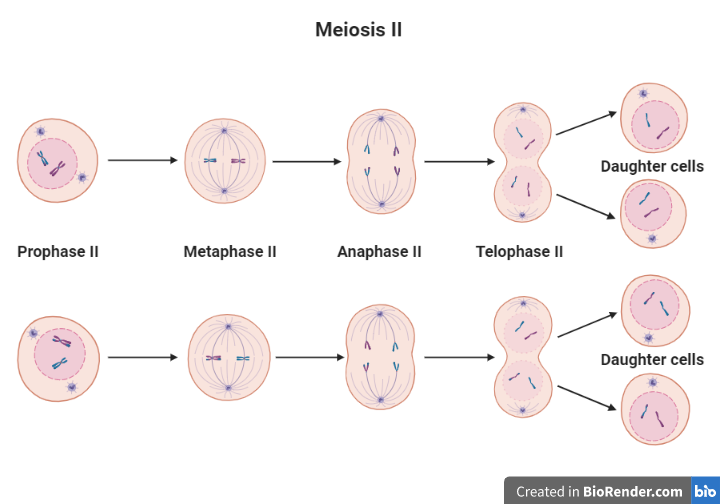
Prophase II
The two new cells will not replicate their DNA before meiosis II begins. That is in comparison to what happens in interphase prior to the first meiotic division. This way, during prophase II, chromosomes are once again condensed and are ready for division. The nuclear envelope dissolves, and the centrosomes create a new meiotic spindle to bind the sister chromatids.
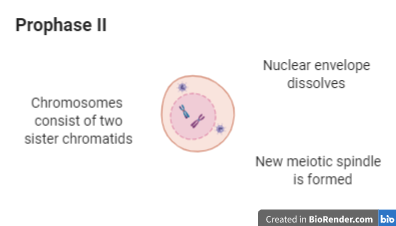
Metaphase II
Now, the chromosomes line up to the equator with the sister chromatids bound to microtubules from opposite poles.
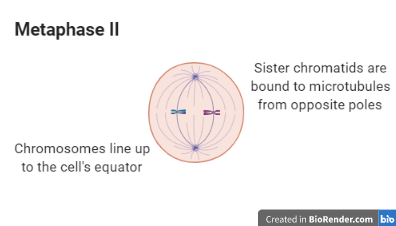
Anaphase II
In anaphase II, the sister chromatids are separated from the centromere. The microtubules pull them towards opposite poles concentrating half of them on one pole and the other half on the other pole. The chromatids are now considered individual chromosomes.
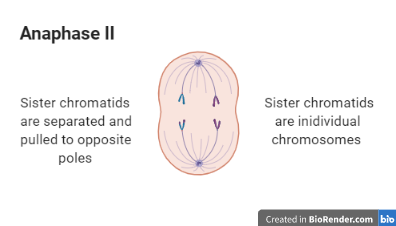
Telophase II and Cytokinesis
In each pole, a new nuclear envelope is created around the chromosomes, while the meiotic spindle is broken down. Cytokinesis occurs again for cytoplasmic division, and each of the two cells splits in two. Four cells emerge, which are genetically different from each other and their original parent cell. Each of them contains one set of non-duplicated chromosomes, and therefore they are considered haploid cells.
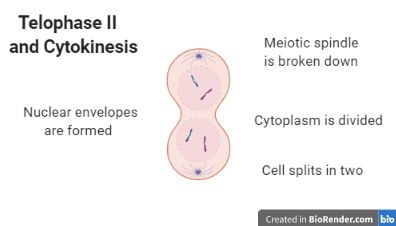
Haploid cells
In humans, after cytokinesis is completed, there are four haploid cells, each one with 23 chromosomes. In males, the four cells are spermatids, which will all develop into sperm cells that can fertilize eggs. In females, however, three of the four cells are called polar bodies. These are small, and they cannot be fertilized. Only one of the four cells will develop into an egg that can be fertilized. The egg is big enough because it contains a lot of cytoplasm, organelles, and various substances that will help in the survival and development of the zygote. The egg cell is big, while the polar bodies are smaller because the cytoplasmic divisions during oogenesis are asymmetric (one daughter cell acquires more cytoplasm than the other).
